Accepted Scientific Name: Discocactus heptacanthus (Barb.Rodr.) Britton & Rose
Cactaceae (Britton & Rose) 3: 218, fig. 232. 1922 Britton & Rose
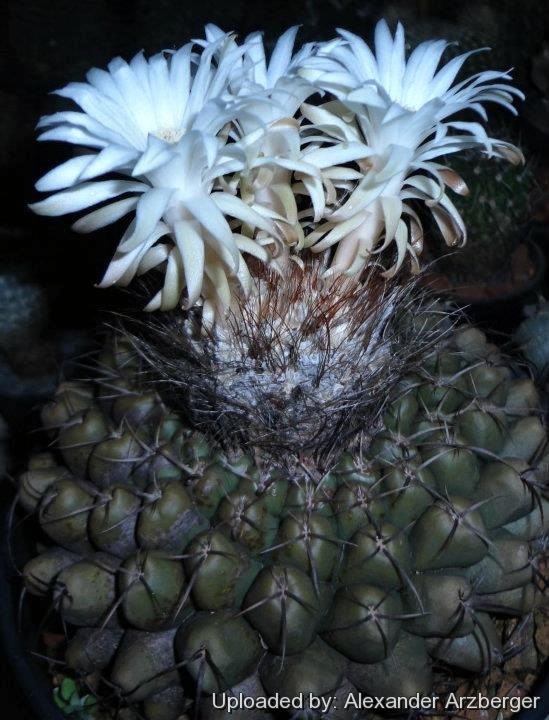
Discocactus hartmannii Photo by: Alexander Arzberger
Origin and Habitat: Paraguay and Brazil. Discocactus hartmanniiSN|33218]]SN|33218]] stretches from the Amambay, Concepción, San Pedro, and Canindeyu departments in Paraguay, into southern Mato Grosso do Sul to southwestern Goiás in Brazil.
Type Locality: Campos am Capivary, Paraguay.
Altitude range: 200-600 metres above sea level.
Habitat and Ecology: This cactus occurs on sandy soils in grasslands that are a very open form of cerrado (campo sujo). In the past Discocactus hartmanniiSN|33218]]SN|33218]] was widespread and common, but now it only occurs in fragmented patches due to severe habitat loss. As a result of deforestation for large-scale agriculture, the populations have declined by an estimated 80% in the last 30 years (generation length is 10 years) and this decline is continuing. In Paraguay, the main threat to the species is livestock ranching.
Synonyms:
See all synonyms of Discocactus heptacanthus
Description: Discocactus hartmanniiSN|12017]]SN|33218]] is a low growing cactus species with simple stems, that are broader than high with rounded ribs cut by deep wrinkles into flat humps. At maturity the plant is crowned by a brown bristly cephalium. The flower opens at night and smells like lily of the valley. It is one of the geographical or morphological forms of Discocactus heptacanthusSN|33218]]SN|12017]] which is one of the most widespread and morphologically variable taxon.
Taxonomy note: The names Discocactus hartmanniiSN|12017]]SN|33218]] is not accepted by many botanists that treat it as synonym of Discocactus heptacanthusSN|33218]]SN|12017]] subs. magnimammus, but it has perianth-segments more acute (not rounded like in subs. magnimammus), and it still has a value for a collector because they identify plants with particular characters.
Stem: Solitary, flattened globose, green, shining up to 6 cm. tall and 15 cm wide.
Ribs: 12 to 22, broad at base, obtuse, bumpy, completely divided transversely into large tubercles.
Spines: Yellow, up to 2 cm long and up to 1,5(-2) mm thick, subulate, often slightly flattened. Radial spines 6 to 12, curved backward and appressed. Central spines solitary, up to 1 cm long.
Cephalium: Composed of long wool and many erect bristles.
Flowers: Up to 10 cm long, white. Flower-tube funnelform, bearing a few spreading scales. Outer perianth-segments green. Inner perianth-segments lanceolate to nearly oblong, acute, white.
Fruit: Yellow, thin-skinned..
Seeds: Globular, 2 mm in diameter.
Subspecies, varieties, forms and cultivars of plants belonging to the Discocactus heptacanthus group
 Discocactus cangaensis Diers & Esteves: has oval-round areoles, very woolly at first. Spines subulate, bent inwards, amber-coloured, the lower ones the longer. Distribution: east of the Rio Caiapo, South-west to west of Goiás, Brazil.
Discocactus cangaensis Diers & Esteves: has oval-round areoles, very woolly at first. Spines subulate, bent inwards, amber-coloured, the lower ones the longer. Distribution: east of the Rio Caiapo, South-west to west of Goiás, Brazil. Discocactus cephaliaciculosus Buining & Bredero ex P.J.Braun & Esteves: has a white cephalium filled with strong, straight and dark red to black spines up 2 cm (or more) cm long. Distribution: southeastern Goiás and northeastern Tocantins, Brazil.
Discocactus cephaliaciculosus Buining & Bredero ex P.J.Braun & Esteves: has a white cephalium filled with strong, straight and dark red to black spines up 2 cm (or more) cm long. Distribution: southeastern Goiás and northeastern Tocantins, Brazil. Discocactus griseus Buining & Bredero: has grey-green colour of the body. Distribution: Serra dos Alegres (near Joao Pinheiro), West Minas Gerais, Brazil.
Discocactus griseus Buining & Bredero: has grey-green colour of the body. Distribution: Serra dos Alegres (near Joao Pinheiro), West Minas Gerais, Brazil. Discocactus hartmannii (K.Schum.) Britton & Rose: has solitary stems up to 6 cm tall and 15 cm wide, completely divided transversely into large tubercles. Perianth-segments acute. Distribution: Paraguay and Brazil.
Discocactus hartmannii (K.Schum.) Britton & Rose: has solitary stems up to 6 cm tall and 15 cm wide, completely divided transversely into large tubercles. Perianth-segments acute. Distribution: Paraguay and Brazil. Discocactus heptacanthus (Barb.Rodr.) Britton & Rose: has typically 7 spines, but variable in number from 5 to 11. Stem solitary flattened. It is a very variable species. Distribution: Eastrern Bolivia, Paraguay, Brazil.
Discocactus heptacanthus (Barb.Rodr.) Britton & Rose: has typically 7 spines, but variable in number from 5 to 11. Stem solitary flattened. It is a very variable species. Distribution: Eastrern Bolivia, Paraguay, Brazil. Discocactus heptacanthus f. aurea hort.: has golden yellow (chlorophylls-less) stems.
Discocactus heptacanthus f. aurea hort.: has golden yellow (chlorophylls-less) stems.- Discocactus heptacanthus subs. catingicola (Buining & Bredero) N.P.Taylor & Zappi
 Discocactus heptacanthus subs. magnimammus (Buining & Bredero) N.P.Taylor & Zappi: has more numerous ribs (up to 22) completely divided into distinct tubercles, and shorter spines that are round in cross section. Distribution: Between Caracol and Bela Vista, Mato Grosso
Discocactus heptacanthus subs. magnimammus (Buining & Bredero) N.P.Taylor & Zappi: has more numerous ribs (up to 22) completely divided into distinct tubercles, and shorter spines that are round in cross section. Distribution: Between Caracol and Bela Vista, Mato Grosso Discocactus mamillosus Buining & Bredero: has more numerous ribs (up to 22), small nipple-like tubercles on the edges, and fewer spines (5-7) in the areole. Distribution: West and north of the Rio Apa in the Mato Grosso.
Discocactus mamillosus Buining & Bredero: has more numerous ribs (up to 22), small nipple-like tubercles on the edges, and fewer spines (5-7) in the areole. Distribution: West and north of the Rio Apa in the Mato Grosso. Discocactus pachythele Buining & Bredero: intermediate between ssp. heptacanthus and ssp. magnimammus. Distribution: Northeast of Aquidauana (Serro de Maracaju) and Cipolandia, Mato Grosso, Brazil
Discocactus pachythele Buining & Bredero: intermediate between ssp. heptacanthus and ssp. magnimammus. Distribution: Northeast of Aquidauana (Serro de Maracaju) and Cipolandia, Mato Grosso, Brazil Discocactus silicicola Buining & Bredero: is variable in shape, but closely related to D. magnimammus, D. mamillosa and D. hartmannii. Distribution: Near Porto Murtinho North of Rio Apa, Mato Grosso do Sul, Brazil
Discocactus silicicola Buining & Bredero: is variable in shape, but closely related to D. magnimammus, D. mamillosa and D. hartmannii. Distribution: Near Porto Murtinho North of Rio Apa, Mato Grosso do Sul, Brazil
Bibliography: Major references and further lectures
1) N. L. Britton, J. N. Rose “The Cactaceae. Descriptions and Illustrations of Plants of the Cactus Family.” Volume 3, The Carnegie Institution of Washington, Washington 1922
2) Willy Cullmann, Erich Götz (Dozent Dr.), Gerhard Gröner “The encyclopedia of cacti” Timber Press, 1987
3) Tim Inskipp, Harriet J. Gillett “Checklist of CITES species and annotated CITES appendices and reservations: a reference to the appendices to the Convention on International Trade in Endangered Species of Wild Fauna and Flora” CITES Secretariat, 2005
4) Willy Cullmann, Erich Götz (Dozent Dr.), Gerhard Gröner “The encyclopedia of cacti” Timber Press, 1987
5) Edward Anderson “The Cactus family” Timber Press, Incorporated, 2001
6) James Cullen, Sabina G. Knees, H. Suzanne Cubey "The European Garden Flora Flowering Plants: A Manual for the Identification of Plants Cultivated in Europe, Both Out-of-Doors and Under Glass" Cambridge University Press, 11/Aug/2011
7) David R Hunt; Nigel P Taylor; Graham Charles; International Cactaceae Systematics Group. "The New Cactus Lexicon" dh books, 2006
8) Franz Buxbaum “Morphology of Cacti”, Volume 1, Abbey Garden Press, 1950
9) Braun, P., Pin, A. & Oakley, L. 2013. Discocactus hartmannii. The IUCN Red List of Threatened Species 2013: e.T152807A680849. http://dx.doi.org/10.2305/IUCN.UK.2013-1.RLTS.T152807A680849.en. Downloaded on 22 November 2016.
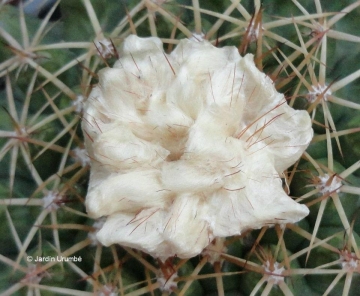 Discocactus hartmannii Photo by: Alexander Arzberger
Discocactus hartmannii Photo by: Alexander Arzberger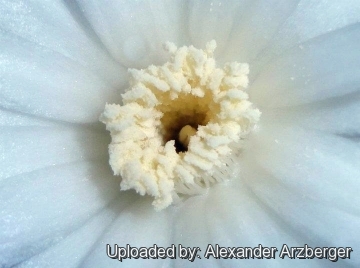 Discocactus hartmannii Photo by: Alexander Arzberger
Discocactus hartmannii Photo by: Alexander Arzberger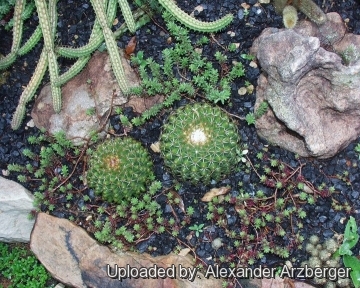 Discocactus hartmannii in the garden under the rain. Photo by: Alexander Arzberger
Discocactus hartmannii in the garden under the rain. Photo by: Alexander Arzberger Discocactus hartmannii Photo by: Alexander Arzberger
Discocactus hartmannii Photo by: Alexander Arzberger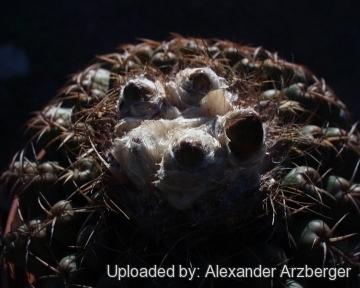 Discocactus hartmannii preparing for an intense flowering. Photo by: Alexander Arzberger
Discocactus hartmannii preparing for an intense flowering. Photo by: Alexander Arzberger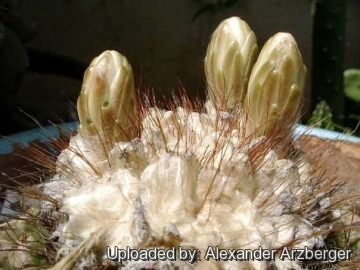 Discocactus hartmannii Photo by: Alexander Arzberger
Discocactus hartmannii Photo by: Alexander Arzberger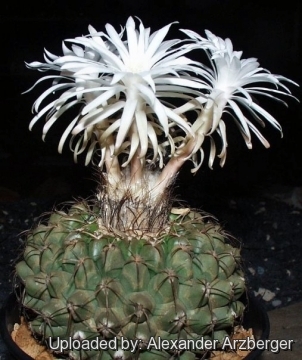 Discocactus hartmannii Photo by: Alexander Arzberger
Discocactus hartmannii Photo by: Alexander Arzberger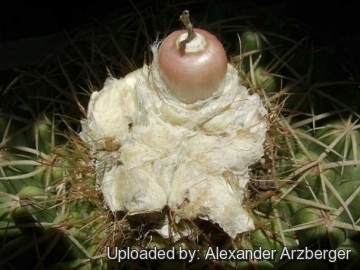 Discocactus hartmannii Photo by: Alexander Arzberger
Discocactus hartmannii Photo by: Alexander ArzbergerCultivation and Propagation: Discocactus hartmannii is not the easiest plant to keep happy, so it isn't a plants for beginners, in fact collectors consider the Discocactus to be rarities which requires skilful cultivation. Under glass, it isn't difficult, but appreciates milder winter temperatures and more generous summer watering than most of the other genera of compact cacti. When grown to maturity, however, it possess an exotic look shared by no other cacti, and it generally attract a lot of attention.
Growing rate: It is slow growing.
Soil: It likes very porous cactus mix soil enriched with humus and decomposed granite rock. Prefer a low pH compost, avoid substrata rich in limestone; otherwise growth will stop altogether.
Repotting: They generally resent being repotted and can take a long time to establish.
Fertilization: Feed with a high potassium fertilizer in summer.
Exposition: The plant tolerates bright situations but enjoys filtered sunlight or afternoon shade, inside it needs bright light, and some direct sun. Tends to bronze in strong light, which encourages flowering and heavy spine production.
Waterings: Discocacti are very rot prone when kept on their own roots and though they can’t endure long stretches of total dryness, too much water with cool will rot them, as their weak root systems tend to be inefficient at sucking up water from wet soil.
Hardiness: It is rather difficult to grow and frost tender, it can’t stand cold, or even fairly cool temperatures and should be kept at above 15° C if grown on its own roots (8°C if grafted).
Traditional uses: The stems were formerly used to produce candy.
Pests & diseases: It may be attractive to a variety of pests or diseases:
- Red spiders: Red spiders may be effectively rubbed up by watering the plants from above.
- Mealy bugs: Mealy bugs occasionally develop aerial into the new growth among the wool with disfiguring results, but the worst types develop underground on the roots and are invisible except by their effects.
- Scales: Scales are rarely a problem.
- Rot: Rot it is only a minor problem with cacti if the plants are watered and “aired” correctly. If they are not, fungicides won't help all that much.
Propagation: Seeds or grafting. Seeds germinate in 7-14 days at 21-27° C in spring, remove gradually the glass cover as soon the plants will be well rooted (ca 1-2 weeks) and keep ventilated, no full sun for young plants! .Young seedlings are often grafted on a low stock to keep the plant in a good shape.
Your Photos

by Alexander Arzberger



















